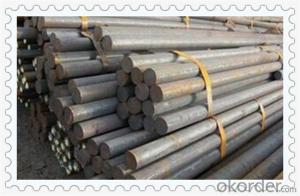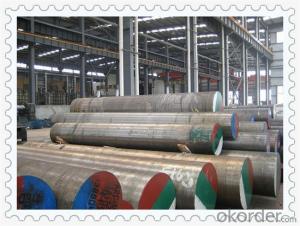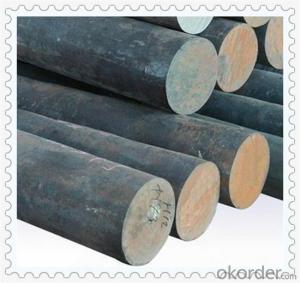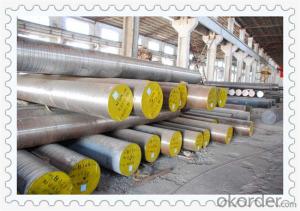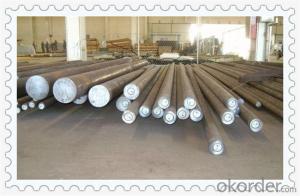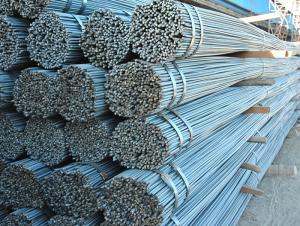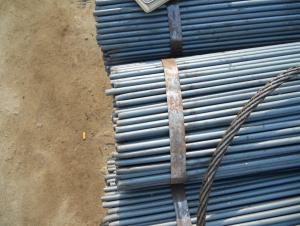AISI 1045 Carbon Steel Round Bar
- Loading Port:
- China main port
- Payment Terms:
- TT OR LC
- Min Order Qty:
- 5 m.t.
- Supply Capability:
- 100000 m.t./month
OKorder Service Pledge
OKorder Financial Service
You Might Also Like
Item specifice
AISI 1045 Carbon Steel Round Bar
Standard | ASTM A29/A29M-04 | ||||||||||
Grade | 1045 | ||||||||||
MOQ | 1 Metric Ton | ||||||||||
Diameter | 12mm~1500mm | ||||||||||
Length | 6m,12m or as required. | ||||||||||
Diameter Tolerance | As required | ||||||||||
Condition of delivery | Hot rolled,Cold Rolled or as required. | ||||||||||
Chemical Composition(%) | |||||||||||
C | Si | Mn | P | S | Cr | ||||||
0.42~0.50% | 0.17~0.37% | 0.50~0.80% | ≤0.035% | ≤0.035% | ≤0.40% | ||||||
Ni | Cu | ||||||||||
≤0.035% | ≤0.25% | ||||||||||
Mechanical Properties(In Quenching and Tempering) | |||||||||||
Tensile strength | Yield strength | Elongation | Reduction in Area | Impact | Hardness | ||||||
(σb/MPa) | (σs/MPa) | (δ5/%) | (ψ/%) | (J) | (HB) | ||||||
≥ 600Mpa | ≥ 355Mpa | 16% | 40% | 39J | ≤229HB | ||||||
Packaging & Shipping
Packaging: According to customer's requirements or export standard.
Shipment: By express,mainly suitable for samples.
By air ,mainly suitable for urgent orders.
By ship ,suitable for large quantities,cheaper but a bit slower.
Our Products
Steel wire, Steel Round bar
Diameter: 0.14mm-2000mm
Steel Square bar
Size : 50mm * 50mm-600mm *600mm
Steel Plate(sheet), flat steel bar
Thickness: 0.1mm-800mm Width: 10mm to 1900mm
Cold-rolled Plate(sheet)
Thickness: 0.1-8mm Width: 1000mm
Hot-rolled Plate(sheet)
Thickness: 6-200mm Width : 210-1900mm
Surface: 2B, BA, 6K, 8K, 12K, etc.
Welded/seamless Steel Pipe(tube)
outer diameter: 6-219mm wall thickness: 1-35 mm.
Length: according to the customer's requirements.
Condition of delivery
Hot-rolling+annealing,normalizing+tempering,quenching+tempering,cold-drawn or according to the customer's requirements.
Surface: rough machining,fine machining,polishing,bright,pickling,black or according to the customers’ requirements.
Furnaces for metallurgical processing: electrode arc + LF,VD,VOD,ESR,Vacuum consumable electrode.
Ultrasonic inspection: 100% ultrasonic inspection for any in perfections or according to the customers’ requirements.
All of our steels can be customized(standard GB, ASTM, JIS, DIN, etc.)
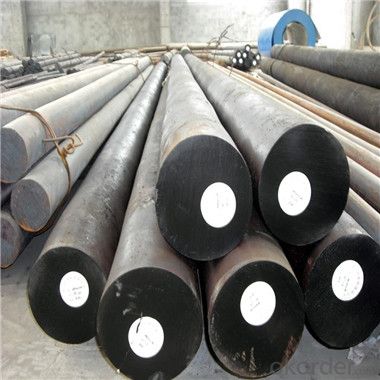

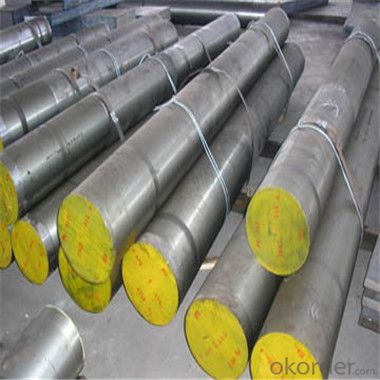
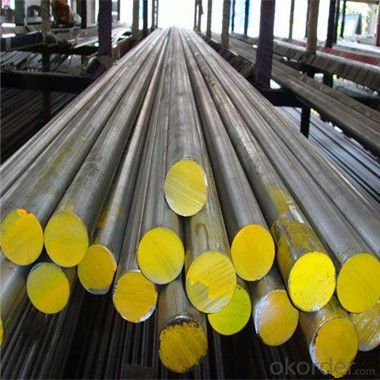
- Q:What is the difference between carbon steel and stainless steel round bars?
- Carbon steel and stainless steel round bars differ primarily in their composition and properties. Carbon steel is primarily made up of iron and carbon, with trace amounts of other elements. It is known for its strength and durability, making it ideal for various applications in industries such as construction and automotive. Carbon steel round bars are generally more affordable than stainless steel round bars. Stainless steel, on the other hand, is a steel alloy that contains at least 10.5% chromium. This addition of chromium gives stainless steel its unique properties, including corrosion resistance. Stainless steel round bars are highly resistant to rust and staining, making them suitable for applications in environments exposed to moisture and chemicals. They are commonly used in industries such as food processing, medical equipment, and marine applications. Due to the chromium content, stainless steel round bars are generally more expensive than carbon steel round bars. However, the added cost is justified by their superior corrosion resistance and aesthetic appeal. Stainless steel also offers different grades and finishes, allowing for customization based on specific requirements. In summary, the main difference between carbon steel and stainless steel round bars lies in their composition and properties. Carbon steel is strong and affordable, while stainless steel offers corrosion resistance and comes in various grades and finishes. The choice between the two depends on the specific application and the desired properties required for the project.
- Q:How do you calculate the weight of a steel round bar based on its volume and density?
- To calculate the weight of a steel round bar based on its volume and density, you can use the formula: Weight = Volume x Density First, determine the volume of the round bar. The volume of a cylinder, which is the shape of a round bar, can be calculated using the formula: Volume = π x (diameter/2)^2 x length Where π is a mathematical constant approximately equal to 3.14159, and the diameter and length are measurements of the round bar. Once you have the volume, you need to know the density of the steel. The density of steel can vary depending on the type and grade of steel being used. The density is usually measured in kilograms per cubic meter (kg/m^3) or pounds per cubic inch (lbs/in^3). You can find the density of steel in reference materials or online. Finally, multiply the volume by the density to obtain the weight of the steel round bar. Make sure the units of volume and density are consistent. For example, if the volume is in cubic inches and the density is in pounds per cubic inch, the weight will be in pounds. If the volume is in cubic meters and the density is in kilograms per cubic meter, the weight will be in kilograms. It is important to note that this calculation assumes the round bar is made entirely of steel and has a uniform density throughout its volume. Additionally, this calculation does not consider any other factors that may affect the weight, such as impurities or surface finish.
- Q:What is the difference between a hot-finished and a cold-finished steel round bar?
- The main difference between a hot-finished and a cold-finished steel round bar lies in the manufacturing process. A hot-finished steel round bar is produced by heating the steel billet or ingot to high temperatures and then rolling it into the desired shape. This process results in a rougher surface, with the bar exhibiting a scale or oxidation layer. On the other hand, a cold-finished steel round bar is produced by further processing the hot-finished bar through additional steps like cold drawing, turning, grinding, or polishing. This process enhances the dimensional accuracy, surface finish, and mechanical properties of the bar. The cold-finished bar has a smoother surface and tighter tolerances, making it suitable for applications that require precision and a higher-quality finish. In summary, while both hot-finished and cold-finished steel round bars serve the same purpose, the cold-finished bar offers improved dimensional accuracy, surface finish, and mechanical properties due to additional processing steps.
- Q:How do steel round bars compare to cast iron bars?
- Steel round bars and cast iron bars have several key differences. Firstly, steel round bars are typically stronger and more durable than cast iron bars. Steel has a higher tensile strength and can withstand greater loads and impacts. On the other hand, cast iron bars are more brittle and can break under excessive pressure. Secondly, steel round bars have better corrosion resistance, making them suitable for outdoor or marine applications. Cast iron bars, however, are prone to rusting and require regular maintenance. Lastly, steel round bars offer greater versatility as they can be easily machined, welded, and formed into various shapes. Cast iron bars are more difficult to manipulate and have limited customization options. Overall, steel round bars are generally preferred in industries where strength, durability, and versatility are crucial factors.
- Q:What are the different types of steel round bar heat treatments?
- Steel round bars can undergo several types of heat treatments, each aiming to enhance specific material properties. Common heat treatments include annealing, normalizing, quenching and tempering, and case hardening. 1. Annealing involves heating the steel round bar to a high temperature and gradually cooling it to room temperature. This process relieves internal stresses, improves machinability, and enhances ductility and toughness. 2. Normalizing, similar to annealing, requires heating the steel round bar to a specific temperature. However, instead of slow cooling, the bar is left to cool in air. Normalizing refines the grain structure, improves mechanical properties, and enhances machinability. 3. Quenching and tempering entails heating the steel round bar to a high temperature and rapidly cooling it using a quenching medium like oil or water. This rapid cooling achieves high hardness and strength. Subsequently, the steel is tempered by reheating it to a lower temperature, enhancing toughness and reducing brittleness. 4. Case hardening is employed to increase the surface hardness of the steel round bar while maintaining a tough core. This treatment involves heating the bar in the presence of carbon-rich substances like gas or liquid carburizing agents. It results in a hardened outer layer, known as the case, while the core remains relatively softer and more ductile. These examples demonstrate the various heat treatments applicable to steel round bars. The choice of heat treatment depends on the desired properties and applications of the steel. Consulting with metallurgical experts ensures the selection of the most appropriate treatment for each specific steel round bar.
- Q:What is the difference between a forged and a peeled steel round bar?
- A forged steel round bar and a peeled steel round bar are both types of steel bars used in various industries for different applications. However, there are distinct differences between the two in terms of their manufacturing processes and physical characteristics. A forged steel round bar is made by heating a solid steel billet to a high temperature and then applying pressure to shape it into the desired form. This process involves the use of machinery, such as hammers or presses, to shape the steel and create the round bar. The forging process imparts strength and durability to the steel, making it suitable for applications that require high strength and resistance to wear and tear. On the other hand, a peeled steel round bar is produced through a different manufacturing process known as peeling or turning. In this process, a solid steel bar is rotated against a cutting tool, which removes the outer layer of the bar, resulting in a smooth and precise surface finish. Peeling removes any surface defects or imperfections present in the original bar, improving its dimensional accuracy and surface quality. In terms of physical characteristics, forged steel round bars typically have a rougher surface texture due to the nature of the forging process. This rough texture can provide enhanced grip or adhesion when used in certain applications. Additionally, forged bars often have a denser and more uniform internal grain structure, which contributes to their superior mechanical properties. Peeled steel round bars, on the other hand, possess a smooth and shiny surface finish as a result of the peeling process. This smooth surface makes peeled bars suitable for applications that require aesthetic appeal or require a low coefficient of friction. However, the peeling process may result in a slight reduction in the overall diameter of the bar. In summary, the main difference between a forged and a peeled steel round bar lies in their manufacturing processes and resulting physical characteristics. Forged bars are created through the application of pressure, resulting in a rougher surface texture and superior mechanical properties. Peeled bars, on the other hand, are produced by removing the outer layer of a steel bar, resulting in a smooth surface finish and improved dimensional accuracy. The choice between these two types of bars ultimately depends on the specific requirements of the application at hand.
- Q:Is round bar steel?
- For example, the steel structure material is Q235B, and the steel bar is HPB235. Although the strength is the same, the production process is still different, the requirements of higher steel bar, there is a new specification more stringent.
- Q:Can steel round bars be threaded?
- Yes, steel round bars can be threaded. Threading is a common process used to create a helical ridge on the surface of a round bar, allowing it to be securely fastened to other components or fittings.
- Q:Weight algorithm of round steel
- 1, the appearance is different, round steel appearance of round, no grain without ribs, other steel surface appearance has carved or ribbed, this causes the round bar and concrete bonding force is small, and other steel and concrete bonding force.2 ingredients are different, round steel (grade a steel) belongs to ordinary low carbon steel, and other steel bars are mostly alloy steel. 3 strength, steel and other steel with high strength low strength, namely, diameter of the same size as compared with other steel, round steel can bear the pulling force than other reinforced small, but the plastic steel reinforced bar is stronger than the other, there is a large deformation in the break before, and it reinforced the deformation the break before the much smaller.
- Q:Can steel round bars be annealed?
- Yes, steel round bars can be annealed. Annealing is a heat treatment process that involves heating the steel to a specific temperature and then gradually cooling it down. This process helps to relieve internal stresses, improve ductility, and enhance the material's machinability. Annealing can be applied to a wide range of steel products, including round bars, to make them softer, more workable, and reduce the risk of cracking or failure during subsequent manufacturing processes.
1. Manufacturer Overview |
|
|---|---|
| Location | |
| Year Established | |
| Annual Output Value | |
| Main Markets | |
| Company Certifications | |
2. Manufacturer Certificates |
|
|---|---|
| a) Certification Name | |
| Range | |
| Reference | |
| Validity Period | |
3. Manufacturer Capability |
|
|---|---|
| a)Trade Capacity | |
| Nearest Port | |
| Export Percentage | |
| No.of Employees in Trade Department | |
| Language Spoken: | |
| b)Factory Information | |
| Factory Size: | |
| No. of Production Lines | |
| Contract Manufacturing | |
| Product Price Range | |
Send your message to us
AISI 1045 Carbon Steel Round Bar
- Loading Port:
- China main port
- Payment Terms:
- TT OR LC
- Min Order Qty:
- 5 m.t.
- Supply Capability:
- 100000 m.t./month
OKorder Service Pledge
OKorder Financial Service
Similar products
New products
Hot products
Related keywords
